How and how to clean the washing machine: the best ways + an overview of special tools
Do you want to extend the smooth operation of your washing machine by cleaning its basic elements? Agree, it’s great when the washing machine works like a clock: loaded the laundry, poured powder, pressed the start. For this, it is worth remembering the most important thing: any technique needs care.
But the range of detergents is very rich and you do not know which one can cope with the task. We will help you figure out how and how to clean the washing machine from a wide variety of contaminants - from scale to banal dirt and the ubiquitous fungus.
The article discusses effective methods of cleaning the heating element with an overview of the most effective means. To avoid damage to an expensive appliance, a flood and other consequences of an oversight, we offer step-by-step instructions on how to perform comprehensive cleaning of all important components and components of a washing machine.
We picked up a photo depicting the important stages of the process, as well as useful videos demonstrating the prevention and maintenance of the unit on our own.
The content of the article:
Why should I clean the washer?
Although the purpose of the machine is to “give” us clean things, the condition of the device itself can be far from sterile.
The internal elements accumulate dirt removed from the clothes during washing. On the sealing gum and the edges of the drum can often be replaced black mold spots, because heat and moisture are ideal conditions for the development of fungal organisms.
And the heating element and other details are gradually covered with a coating of salts that are in the water.

The main sources of pollution:
- high salinity of water;
- the use of aggressive chemicals and detergents of poor quality;
- improper use of the device;
- washing heavily contaminated items - robes with the remnants of mortars or machine oil, clothes after garden work, etc.
So, to bring your assistant in a perfectly clean look, it's time to arrange a general cleaning, starting from the building itself and ending with internal details.
To wash obvious external contaminants (drips of gel, conditioner, traces of powder) enough warm water and a sponge. But with the details hidden in the bowels of the unit, you have to work hard.
We remove scale from the heater and internal elements
One of the most serious accidents that can easily happen in the absence of proper care of the washing machine is the failure of the tubular electric heater.

Since the heater is in contact with running water, scum forms on it after each wash - deposits of calcium and magnesium salts.
Therefore, if a softening filter is not installed in the drain, it is recommended to add special products to the powder (for example, Calgon) and at least once a month to take preventive measures.
Method # 1 - stocks at hand
One of the easiest and most effective ways to deal with calcareous deposits is to pour tribasic carbon or citric acid into the powder compartment and turn on any mode with high temperature.
This recipe works simply: when heated, the acid actively corrodes not only light deposits, but also caked limestone, as a result of which it cleans both the heater and the drum steel.

The calculation of the required amount of powder must be done based on the degree of contamination of the machine and its capacity. On average, about 25-30 grams of acid is consumed per kilogram of load.
If the unit has not been cleaned for a long time, you can take note of the following advice: pour acid into the powder container, start any long-term washing mode with a temperature of 90 ° C and disconnect the power supply from the mains in the middle of the process. Leave overnight, and start the machine again in the morning.
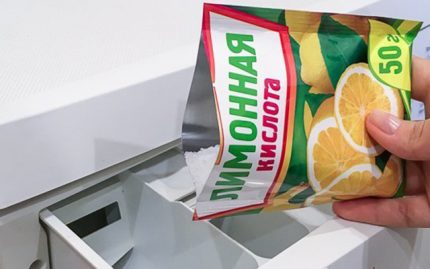
This procedure is recommended to be used no more than 4 times a year, and after each time it is necessary to check the drain hose and the cuff of the drum in order to remove large particles of exfoliated limestone.
Other home remedies and their use:
- Table vinegar - pour 1-2 cups of a 9-percent solution of acetic acid into the detergent cuvette, select a high-temperature regime with long washing and pre-soaking. To get rid of a specific acid smell, you can then turn on an additional rinse.
- Baking soda and vinegar - to enhance the effect of acid on limescale, a special solution is useful. It is prepared as follows: half a glass of soda is mixed with the same amount of water and placed in a container for powder, and 1 glass of 9% vinegar is poured into the drum. Then the machine starts in any continuous mode at maximum temperature.
- White and other chlorine-based products - Old-fashioned used by many housewives for the comprehensive cleaning and disinfection of the washing machine.
But in fact, the effectiveness of caustic preparations is very doubtful: they will not save from scale, but some elements (for example, a rubber cuff of a drum and various sealing gaskets) can be very damaging. Yes, and chlorine vapor is harmful to health.
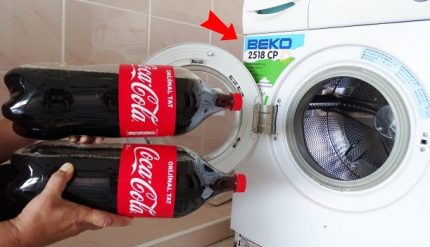
But we considered the most reliable, cheap, safe and field-proven methods for getting rid of scale using improvised tools.
Method # 2 - special chemicals
Means for cleaning the elements of the washing machine should be safe for humans, fabrics and all internal surfaces of the appliance, as well as effectively remove lime deposits and other contaminants.
Specialized preparations have an important advantage over “popular” ones - their composition is developed taking into account the design features of the device and does not harm one element, cleansing the other.
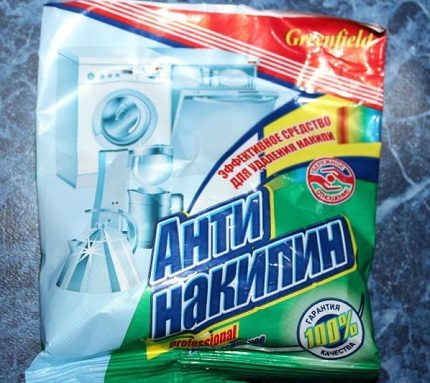
Overview popular specialized tools:
- Topperr 3004 (Germany) - descaler, suitable for dishwashers and washing machines. Well removes scale of various degrees, recommended by Bosh manufacturers.
- Schnell entkalker - powder for quick cleaning of internal elements from stable calcareous deposits. It is made in Germany, produced in packs of 200 g.
- Antikalk for Washing Machines by Sano (Israel) - a universal gel for the prevention and elimination of a small plaque with an antibacterial effect.
- Magic power (Germany) - one of the best specialized tools for washing machines. Available in the form of a gel and powder, which effectively removes plaque from the heater, tank, drum.
- Beckmann (Germany) - a universal drug that will protect against scale and odor caused by various contaminants. But, like any multidisciplinary tool, it is not bad for regular care, but it will be ineffective against strong pollution.
- Filtero 601 (Germany) - well removes old scale from the heater and other elements, it is recommended to use 3-4 times a year for intensive cleaning of the machine. Available in 200 g packages for one use only.
- Dr. TEN (Russia) and Decalcifier (Belarus) - analog powder preparations intended only for descaling, but with any equipment. Inexpensive and convenient solution to the problem with lime deposits on the heating elements of both a washing machine and a dishwasher.
Please note that many products, which, judging by the advertising, are guaranteed to protect our machine from plaque problems, but will not relieve the existing scale, but simply reduce the concentration of salts in the water, for example, the same Calgon.
It’s easy to distinguish them - it’s recommended to add such preparations before starting the machine with the powder or directly into the drum, and they are used during washing things.
Method # 3 - Manual Cleaning
If you have never thought about how to clean your washing machine and all its key elements, and the assistant has served you for more than one year, it is recommended that you first conduct a visual inspection of the heater.
Most likely, a multilayer calcareous stone has already formed on the heating element, which will be easier to remove manually - with standard cleaning methods, cracked solid particles of plaque may remain inside the unit.
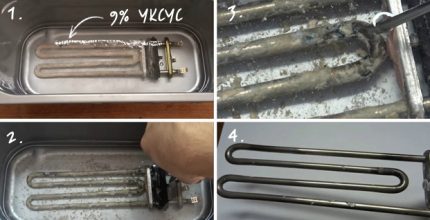
To clean the heater we proceed in stages:
- We disconnect the wires, the sensor and take out the heating element. Scale and dirt can interfere with the process, therefore, after weakened the mount, gently pry the metal flange with a flat screwdriver.But be careful and act smoothly so as not to damage the tank itself and the wiring.
- We wash the heater under a good pressure of warm waterto remove loose plaque and dirt.
- We make a concentrated solution to remove stone residues: pour 3-4 tablespoons into a plastic bottle with a cut neck citric acid powder, put inside the heater and fill it with hot water to the level of the bar.
- Shake the liquid to activate the cleaning process.. The fact that the salts of magnesium and calcium began to dissolve, prompting rising air bubbles.
In this state, leave the heater to soak overnight. In the morning, rinse the metal under running water with a soft sponge, wipe it dry, admire the glare of light on a sparkling stainless steel and install the element back into the device.
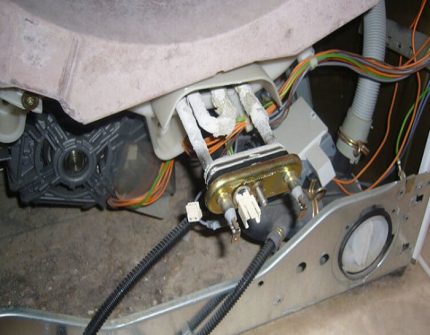
By the way, if you take apart the machine, you can at the same time inspect the condition of the drum. You may also have to dismantle it in order to clean all the holes and remove scale and mold.
But this is not worth doing without extreme necessity and skills in working with equipment; you can get by with processing with good special equipment.
Complex cleaning procedure
In addition to scale, there are other problems that are caused by improper operation of the machine: dirt, bad smell, mold. Therefore, maintaining the cleanliness of internal elements should be done regularly.
Step # 1 - wash the drum
After each wash, water and dirt remain in the drum. And soon black spots appear in the folds of the sealing cuff, and from the bowels of the machine pulls musty.
An idle start with the addition of disinfectants or ordinary citric acid will help solve the odor issue. But the gum needs to be thoroughly cleaned by hand.
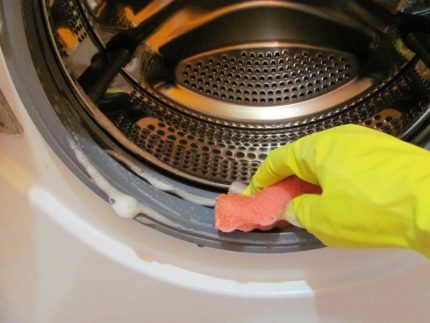
The easiest option is to gently push the folds, wash the cuff around the circumference with a sponge, soap and warm water, then wipe it dry.
If you notice mold stains, you can use a solution of copper sulfate or prepare a cleaning paste from water and baking soda in equal proportions.
Then, with this compound, thoroughly treat the gum and the entire drum, leave for a couple of hours, and then wipe it with a sponge and start the long-term washing mode.
For more information on cleaning the washing machine drum, see this article.
Step # 2 - clean the filter and drain hose
Invisible debris can also become a cause of an unpleasant smell - hair, particles of soil or building materials, fibers, feathers and various small objects that are not removed from the pockets of clothes in time.
All this accumulates in the filter and hose through which the machine releases the waste water. Recommended cleaning the drain filter washing machine at least once every 3 months, and with active use it is possible more often.
To do this, remove the protective panel, substitute a small container for draining water or put a rag on the floor. Then unscrew and remove the filter counterclockwise. Rinse it under the pressure of water, and remove accumulated debris from the hole.
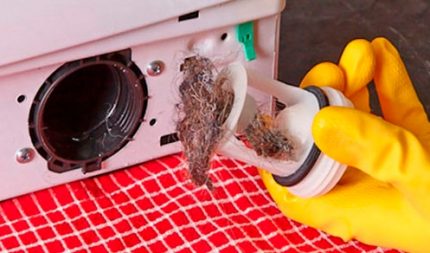
To flush the hose, you need to drain the remaining water in the machine through the drain filter, and then disconnect it from the inlet to the sewer pipe or siphon. After that, you can remove the part, and exactly how to do it, depends on the design of the device itself.
For example, in cars Ariston, Samsung, Indesit, LG, Whirpool, Ardo to get to the place of connection of the hose is possible only through the bottom.
To do this, lay the device on its side, remove the bottom panel and filter, and unclip the clamp with pliers. It remains to disconnect the pump and remove the hose itself.
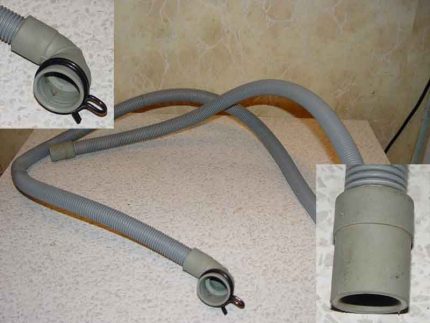
In cars Electrolux and Zanussi You need to look for the drain mount behind the back panel, and Bosch and Siemens behind the front when it comes to front-loading cars.
But with vertical models, you can get to the hose only through the side cover. Therefore, it will not be superfluous to refer to the instructions, which describe the device device diagram.
To clean the drainage hose from dirt and powder coating, arm yourself with a thin non-metallic cable, at one end of which a mini-brush is attached.
Run this brush inward, scroll and gradually push it to the end of the hose. Then we rinse under the pressure of warm water. With severe contamination, several passes can be made.
Step # 3 - wash the powder container
A rough coating of hard water appears on the walls of the detergent compartment, traces of drips of powder and various rinses remain. All this needs to be removed.
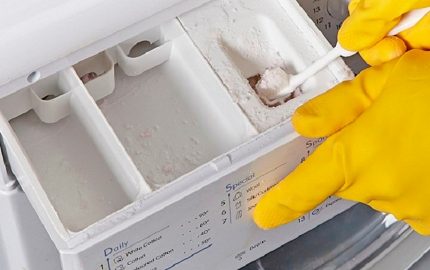
We act in stages:
- We remove the cuvette from the compartment, take out the container for the air conditioner.
- We rinse under running water, wipe mold stains with soda or any chlorine-based product (there are no rubber elements here, so chlorine will not hurt).
- Pour a bag of citric acid into a small bowl.
- We place the disassembled cuvette, fill it with hot water and leave it for an hour (with severe contamination, it can be done at night).
- Then the remnants of plaque are removed with a sponge and thoroughly clean all joints with a toothbrush.
- Dry the container, assemble and install in place.
Another option to combat plaque is to fill the extracted cuvette with soda and pour vinegar into the table. As a result of the reaction, the soda foams and softens the calcareous deposits, so that it is easier to remove.
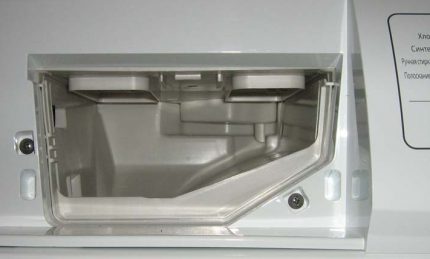
To get rid of dirt and plaque in the container compartment, you can use the same soda paste and toothbrush, and pre-treatment of the tray with cleaning agent from the spray can help speed up the process.
Rules for caring for a washing machine
If you regularly look after your assistant, you can do without disassembling the design and unplanned replacement of its elements. And for this you just need to follow a few simple rules.

Recommendations and useful care tips:
- After washing, always wipe the door glass, drum and gum dry, and rinse the powder container under good pressure of warm water and dry it.
- If your area has hard water, you can equip the machine’s water supply hose with a magnetic filter. The flow will pass through a magnetic field and change the crystalline structure of water, as a result of which scale simply does not form.
- Wash blankets, sweaters and other lint items in a special fine-mesh bag.
- Do not leave wet clothes in the typewriter even for a couple of hours - in addition to the unpleasant smell, the consequences of such forgetfulness will soon appear with black mold spots.
- Promptly remove powder stains, water leaks, and grease spatter (applies to appliances installed in the kitchen) from the cabinet.
Depending on the time the spot appeared, the options for getting rid of it will differ.To remove fresh contamination, just wipe the plastic with a cloth moistened with water or a dishwashing liquid. And with old yellow spots and stains, a paste from soda will help to cope.
The frequency of preventative cleaning with home or professional products depends on the quality of the water in your system, the use of emollients and how often you use the washing machine.
On average, the procedure for disinfestation and descaling should be carried out every 2-3 months. And do not forget to rinse the filter and drum cuff from lime particles after all cleaning compositions.
Conclusions and useful video on the topic
Dirt and scale threaten not only the breakdown of the device. At first, they become the cause of subtle problems, for example, increase the operating time of the machine, the consumption of electricity and detergents.
To avoid this, we suggest that you study the visual instructions for caring for the machine.
Recommendations for the comprehensive cleaning of washing units:
How to remove strong scale from the surface of a heating element:
We clean the powder container with soda and vinegar:
How to remove and rinse the filter from dirt and other accumulations of debris:
Caring for a washing machine is quite simple. However, if you neglect the recommendations for use, soon your assistant may need professional "resuscitation", the replacement of the heater and other elements. To prevent this from happening, carry out timely preventive maintenance on your own or entrust it to specialists.
Have something to supplement, or have questions about cleaning and maintaining the washing machine? You can leave comments on the publication, participate in discussions and share your own experience in caring for a home assistant. The contact form is located in the lower block.

 How to clean a washing machine with citric acid: advantages and disadvantages of the method
How to clean a washing machine with citric acid: advantages and disadvantages of the method 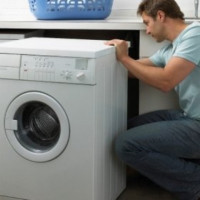 How to independently connect a washing machine: step-by-step installation instructions
How to independently connect a washing machine: step-by-step installation instructions 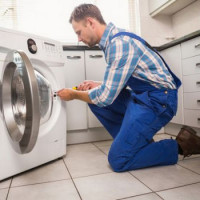 How to disassemble a washing machine: the nuances of disassembling models of different brands
How to disassemble a washing machine: the nuances of disassembling models of different brands 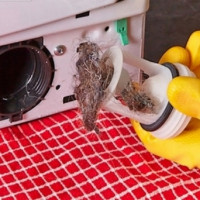 How to clean a filter in a washing machine: an overview of best practices
How to clean a filter in a washing machine: an overview of best practices  How to open a washing machine if it is locked: repair guide
How to open a washing machine if it is locked: repair guide  The washing machine does not pick up water: causes of breakdown and possible ways to fix it
The washing machine does not pick up water: causes of breakdown and possible ways to fix it  How much does it cost to connect gas to a private house: the price of organizing gas supply
How much does it cost to connect gas to a private house: the price of organizing gas supply  The best washing machines with dryer: model rating and customer tips
The best washing machines with dryer: model rating and customer tips  What is the color temperature of light and the nuances of choosing the temperature of the lamps to suit your needs
What is the color temperature of light and the nuances of choosing the temperature of the lamps to suit your needs  Replacement of a geyser in an apartment: replacement paperwork + basic norms and requirements
Replacement of a geyser in an apartment: replacement paperwork + basic norms and requirements
I am ashamed to admit, but for a long time I did not clean the sealing gum. And when I threw the laundry into the washing machine once again, after washing it became even dirtier. On all things, I noticed sticky pieces of dust. When she began to understand what was the reason, the first thing she decided to look under the seal and was horrified. What was not there. Now after each wash I bring the seal in order.
Now there are many effective chemical pills: you throw in the drum, and you're done. But you can always try to clean it yourself from improvised means without leaving your home to the market for a means, though it does not always help. From personal experience, I can say that the most effective way is to use ordinary vinegar. Pour and start two glasses into the powder compartment for the longest washing cycle. I checked on my typewriter, after that it shines like new.
Thank you for the article. My washing machine broke recently, although I myself did not fix it, I turned to a service center in Moscow. To monitor the work of the masters, it is also very useful to understand the causes and methods of eliminating breakdowns.
Well, I don’t know, some are wise of course with citric acid and so on, I wouldn’t do that .. after all, there are a lot of special products. I don’t have the most expensive indesit, but even I wouldn’t like to understand it, than to clean it, you never know ... it's better to play it safe.
In my opinion, with regard to ten, it’s easier once a year or two to stupidly change it to a new one than to buy all these calgons. It will be cheaper. The average ten costs around 1000 rubles. Not such a big amount. Better yet, put a prefilter, then you have to change it even less often.
Thank you very much! I descaled TEN of my indesit Schnell Entkalker. I do this for the sake of maintaining order, so to speak. But there are no problems for as long as 6 years and nothing is breaking.